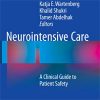Clustering Algorithms Usage in Critical Care Research Unravel Patient Heterogeneity
link.springer.comCritically ill patients constitute the most heterogeneous population in the hospital, with the highest rates of acute and chronic multi-morbidity. Daily, two critically ill patients are admitted to the ICU with the same syndrome-based diagnosis, receive similar treatment, and yet have diametrically opposite outcomes.
Increasingly flexible and sophisticated clustering techniques are available, which can allow for analyses of higher-dimensional data-sets that help better characterize patients, disease mechanisms, and heterogeneous treatment response patterns.
Before these findings can truly inform the design of multi-center, international prospective studies and trials, efforts to increase the interpretability of the findings are essential. For instance, the Interpretable Clustering via Optimal Trees algorithm developed by Bertsimas et al. provides a clear, tree-based representation of the most important variables and the respective thresholds which led to cluster formation.

















